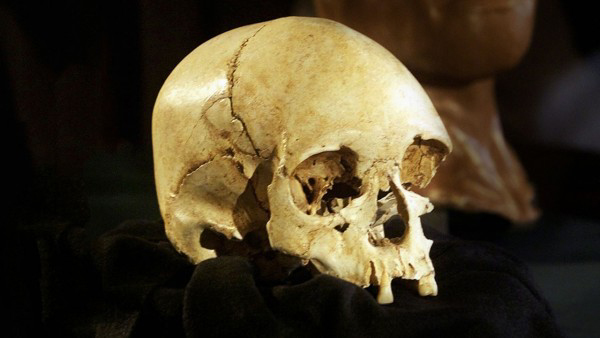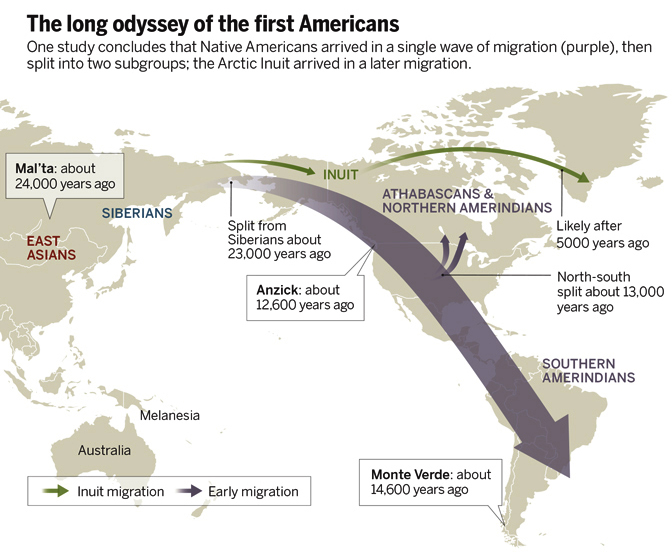


The peopling of the Americas: the mysterious link between Native Americans and people half a globe away revealed by some of the latest genetic research
An online article by Michael Balter on sciencemag.org - Mysterious link emerges between Native Americans and people half a globe away - reports on some of the latest genetic research on the peopling of the Americas.

Despite having an unusual skull, DNA suggests that ancient people like Brazil's 'Luzia' were related to Native Americans.
Image: Reuters/Corbis
The peopling of the Americas remains controversial, and two recent major studies of the DNA of living and ancient people try to establish who they were, when they came, and how many waves arrived.
The two independent studies do not present a single consensus; published online in Science and Nature, they do however detect in modern Native Americans a trace of DNA related to that of native people from Australia and Melanesia.
Science co-author David Meltzer, archaeologist at Southern Methodist University in Dallas, Texas, states that there is a key difference in when and how they arrived in the New World.
The Nature team states that they came in one of two early waves of migration into the continent, whereas the Science team concludes it came much later, and was unrelated to the initial peopling.
Science paper - the researchers sequenced 31 complete and 79 partial genomes from people in North and South America, Siberia, and Oceania. They compared these with previously sequenced genomes of three ancient skeletons: the 24,000-year-old Mal'ta child from Siberia, the 12,600-year-old Anzick child from Montana, and the 4000-year-old Saqqaq individual from Greenland.
The team examined the genetic differences among their samples to determine how long ago various populations diverged, using the ancient genomes to calibrate this DNA clock. They concluded that all Native Americans, ancient and modern, stem from a single source population in Siberia that split from other Asians around 23,000 years ago and moved into the now-drowned land of Beringia.
After up to 8,000 years in Beringia a slightly shorter stop than some researchers have suggested they spread in a single wave into the Americas and then split into?northern and southern branches about 13,000 years ago.

Adapted from Rhagavan et al., Science
The Science team also found a surprising amount of Australo-Melanesian DNA in some living Native Americans, including those of the Aleutian Islands and the Surui people of Amazonian Brazil. The researchers dispute the Paleoamerican model - people descended from an early wave of migration that was separate from the one that gave rise to today's Native Americans, and drew on a different source population in Asia - claiming that a possible explanation might be through gene flow. Ancestors of some of today's South Americans might have mixed with Asian populations related to today's Australo-Melanesians and carried those genes into the Americas during a well-established later wave of migration from Asia that also peopled the Aleutian Islands.
However, Mark Hubbe of Ohio State University counters that the study could have missed telltale DNA in the ancient populations because its sample size is extremely small. Geneticist David Reich of Harvard Medical School in Boston and leader of the Nature team, agrees, noting that the genomes from the 17 ancient relict populations are incomplete and provide very low coverage.
His own paper also finds the Australo-Melanesian DNA in some of the same modern populations, but reaches a different conclusion about its source. His team analyzed partial genome sequences of 106 Native Americans from 25 populations in Central and South America, and compared them with DNA data from 197 populations from outside the Americas. They found that some Amazonians, including the Surui people, shared about 1% to 2% of their ancestry with present-day native people from Australia, New Guinea, and the Andaman Islands. Differences in the shared DNA suggest this ancestry did not come directly from these populations, but through a now extinct population they call 'Population Y' that may have lived somewhere in East Asia and contributed genes to both very early Paleoamericans and to Australo-Melanesians.
Because the Amazonian groups are only distantly related to Population Y, the team concludes that this represents an ancient rather than recent genetic contribution that arrived in an early 'pulse of migration' to the Americas.
Despite their differences, the two camps agree that more genomes from modern and ancient Native Americans are needed to establish the genetic picture.
Visit the Bradshaw Foundation's Journey of Mankind Genetic Map, based on the research of Professor Stephen Oppenheimer:
http://www.bradshawfoundation.com/stephenoppenheimer/index.php
by Bradshaw Foundation
Tuesday 21 March 2023
by Bradshaw Foundation
Tuesday 07 February 2023
by Bradshaw Foundation
Thursday 19 May 2022
by Bradshaw Foundation
Tuesday 19 October 2021
by Bradshaw Foundation
Friday 25 June 2021
by Bradshaw Foundation
Monday 09 November 2020
by Bradshaw Foundation
Tuesday 03 November 2020
by Bradshaw Foundation
Wednesday 28 October 2020
by Bradshaw Foundation
Tuesday 23 June 2020
by Bradshaw Foundation
Thursday 04 June 2020
by Bradshaw Foundation
Thursday 14 May 2020
by Bradshaw Foundation
Tuesday 12 May 2020
by Bradshaw Foundation
Wednesday 19 February 2020
by Bradshaw Foundation
Tuesday 21 January 2020
by Bradshaw Foundation
Monday 20 January 2020
by Bradshaw Foundation
Thursday 28 November 2019
by Bradshaw Foundation
Tuesday 21 March 2023
by Bradshaw Foundation
Tuesday 07 February 2023
by Bradshaw Foundation
Thursday 19 May 2022
by Bradshaw Foundation
Tuesday 19 October 2021
by Bradshaw Foundation
Friday 25 June 2021
by Bradshaw Foundation
Monday 09 November 2020
by Bradshaw Foundation
Tuesday 03 November 2020
by Bradshaw Foundation
Wednesday 28 October 2020
by Bradshaw Foundation
Tuesday 23 June 2020
by Bradshaw Foundation
Thursday 04 June 2020
by Bradshaw Foundation
Thursday 14 May 2020
by Bradshaw Foundation
Tuesday 12 May 2020
by Bradshaw Foundation
Wednesday 19 February 2020
by Bradshaw Foundation
Tuesday 21 January 2020
by Bradshaw Foundation
Monday 20 January 2020
by Bradshaw Foundation
Thursday 28 November 2019
Friend of the Foundation











